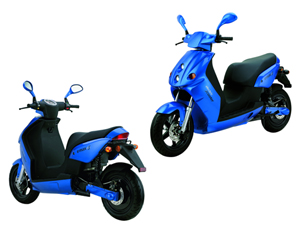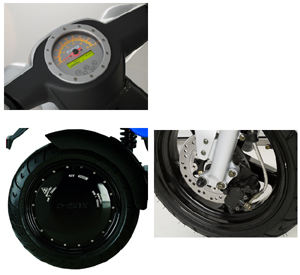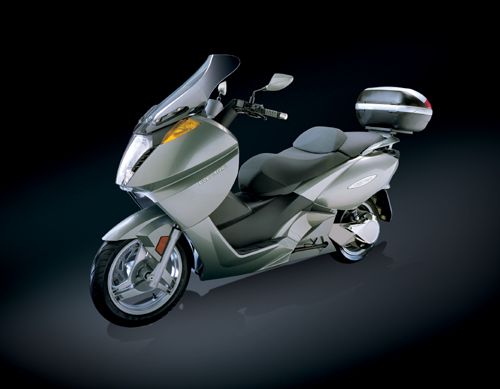Green, e-Vehicles Turn Heads at 2008 INTERMOT Cologne
2008/12/25 | By Quincy LiangIf there was any doubt that a green revolution is gathering force in the motorcycle and scooter sectors, 2008 INTERMOT Cologne put it to rest. Electric vehicles were the star attractions at the world's third-biggest motorcycle and scooter show, which ran from October 8 to 10.
While pump prices are falling, electric powered two-wheelers (PTWs) have been riding the momentum of eco-friendly sentiment and performance improvements, and better batteries and improved battery management system (BMS) technology are making electric a viable alternative to gas in the two-wheeled world. Traffic congestion and scarcity of parking space are further convincing consumers of the benefits of leaving their cars at home.

At 2008 INTERMOT Cologne, there were many eye-catching electric two-wheelers on display, most of them commercialization-ready.
e-max ev's Germany
The e-max ev's Germany is a rising force in the electric-scooter market. The company produces scooters in mainland China and works with Italian designers to give its products their head-turning appeal. The company has commercialized two e-scooter models in Germany this year and is set for a pan-European launch in 2009.

Both e-max models are powered by 4,000-watt motors with an output up to 3.9 kW (5.1 horsepower, or HP) and an adjusted maximum speed (for Europe) of 45 km/h (28 miles/h). The 90s has a range of 45 to 60 km while the 110s can travel about 70 to 90 km on a charge.

The e-max has a digital battery gauge, hydraulic floating disc brakes on the front and rear wheels and a rear single suspension system. The silicone lead-acid batteries can be fully charged from a normal wall outlet in three to five hours (for e-max 90S) and four to eight hours (e-max 110S). Riders can travel about 100km on the bikes at an electricity cost of about 0.5 euro-a bargain compared to prices at the pump.
Golla claims that there are no same-class competitor in Europe that can parallel the quality, performance, and economy of the e-max. The two models weigh 151kg and 191kg, respectively. The company is scheduled to push also a lithium-ion battery high-end model in 2009.
High-end Electric Maxi-Scooter
Another company joining the "quiet revolution" of electric scooters is Vectrix Corp., a U.S. company that debuted its high-end Vectrix Maxi-Scooter in Europe in 2008.
Unlike most e-scooters, which tend to reveal under-150cc gasoline-scooter models, the Vectrix Maxi-Scooter is a high-powered electric two-wheel vehicle designed specifically to compete with large gasoline-powered models. It offers breathtaking acceleration, low running costs, minimal maintenance, simple operation, low noise, and zero emissions.
The price tag of the beautiful and high-end e-machine is an evidence of the firm's strategy to position itself as a premium brand in the upper market. According to Sven Wedemeyer, sales and marketing manager of Vectrix Deutschland GmbH, the electric maxi-scooter is priced at 10,000 euro. The price seems less eye-popping when one considers all the bells advanced features of the Vectrix, from Brembo brake calipers and Mazocchi telescopic front forks to Sachs twin shock absorbers and Pirelli high-end tires.
According to Wedemeyer, the Vectrix MAXI-Scooter is the perfect solution for both urban commuting and recreational riding. Its top speed of 100 km/h (62 mph) and fast acceleration make it easy and safe to shuttle in and out of city traffic. The onboard charger plugs into any standard 110/220V power outlet can quickly recharge the batteries in two hours (80%) or three to four hours (full charge).
Thanks to its wide- and long-body design, the Vectrix Maxi-Scooter offers a very large storage space. Its top range is 110km (68 miles) on a single charge, making it a leader of its class. The under-seat compartment can stow a helmet and the glove box provides additional storage. You can even charge your cell phone and other electronic devices from the integrated 12-volt power outlet.
The maxi-scooter is as fun to ride as it is easy to operate. A low center of gravity and stiff aluminum lightweight frame provide excellent handling, and the patented throttle-activated regenerative braking system slows the Vectrix AXI-Scooter smoothly and safely. Parking of the relative-big scooter is easy with the slow-speed reverse function.
The high-level e-machine is managed and controlled by a raft of high-tech systems. Turn the throttle one way to accelerate and back to slow down smoothly and safely. The patented regenerative braking system (DAaRT) redirects energy back into the battery pack, extending the range of the bike by up to 12%, Wedemeyer said.
The Vectrix Maxi-Scooter is powered by the nickel metal hydride (NiMH) battery pack has an estimated life of up to 10 years based on a usage level of 8,000 km (5,000 miles) per year.
Man-machine Hybrid Motorcycle
One of the more unusual products on display this year was the eROCKIT, though with a price tag of 29,000 euro, millionaires may be the target market at first.
Developed by ErockIT Gmbh of Germany, the eROCKIT resembles an electric bicycle on steroids. The motorcycle is driven by a hybrid system of electricity and pedal power. The bike accelerates by peddling, with extra propulsion delivered from the electric motor. No sluggard, the stylish bike can reach a maximum speed of 80 km/h (about 50 mph).
The operating range of the vehicle reaches 60 to 80 km (37 to 50 miles), depending on driving and road conditions.
The eROCKIT has a serial hybrid propulsion system that lets the rider control the motor speed through a crank assembly and an inter-connected generator. The generator monitors the rotation of the crank assembly and sends an output signal to the control electronics according to the rider's peddling speed. The control electronics steers the electric motor with the received signal as a reference point. The faster you peddle, the faster the motor rotates the rear wheel. The generator thus has a double role of sending signals to the control electronics and transferring the peddling force into electricity to recharge the battery.
The unique machine uses lithium-ion nano-phosphate batteries with high power and long lifespan. They can be recharged at regular, household power plugs and are fully charged in about three hours. The eROCKIT battery pack is contained in a carbon-fiber reinforced box. In addition, the vehicle adopts regenerative braking by means of an additional electric brake and thus captures braking energy and uses it to recharge its batteries.
The eROCKIT also is made with high-end motorcycle parts, such as suspension forks, shock absorbers, wheels and braking systems.
Representatives of ErockIT pointed out that the company was founded in 2005 to develop a new kind of "highly emotional electric motorcycle." Four prototypes have been built and successfully tested so far, he said. The company plans to produce only 10 vehicles in 2009.
World's First e-Motocross
eKRAD of Germany unveiled the world's first motocross bike with electric drive and full off-road fitness. The bike is designed to minimize damage to nature without sacrificing power and off-road capability.
The eKRAD electric off-road bike is available in two versions, the Enduro and Supermoto. Both versions beat existing electric motorcycles in agility, strength, and user benefits, the company claims.
The eKRAD closely resembles its gas-powered counterparts, but in the engine compartment one will find lithium-polymer batteries that can be fully charged in four hours and a 72 volt high-performance electric motor. The bikes come in two performance options--the G series with a top speed of 90 km/h; and the S series with a maximum speed of 120 km/h. The former weighs 96 kg and the latter 101 kg.
World's First Mass-produced Methanol Fuel-cell
At the show, SFC Smart Fuel Cell AG of Germany demonstrated the world's first mass-produced mobile fuel-cell unit that turns methanol into electricity power. Kai Steckmann, manager of SFC's mobility business development, claimed that his company's EFOY 600 fuel-cell unit weighs only about 8 kg and is the world's cheapest standard fuel-cell unit. A total of 10,000 EFOY fuel cells have been sold worldwide for remote power supplies, weather stations, hidden cameras and other applications.
The fuel cell has many advantages, Steckmann said, such as delivering electrical power anytime, anywhere and under extreme weather conditions. On a light scooter model, five liters methanol can generate enough power a 300km ride.
The EFOY 600 has a rated output of 25W and its charging capacity per day is 600Wh (50 Ah), leading to a 1.6 kWh per 24 hours. With the fuel-cell unit, Steckmann explained, you could let the unit transfer the power from methanol into electricity at night and wake up to a recharged battery in the morning.
SFC has also developed other bigger-capacity fuel-cell systems with a daily charging capacity of 1,600 Wh (130Ah). Unfortunately, the systems are still too expensive and heavy for electric scooter applications.




